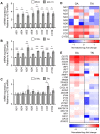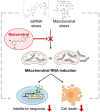Resveratrol Attenuates the Mitochondrial RNA-Mediated Cellular Response to Immunogenic Stress
- PMID: 37108567
- PMCID: PMC10138523
- DOI: 10.3390/ijms24087403
Resveratrol Attenuates the Mitochondrial RNA-Mediated Cellular Response to Immunogenic Stress
Abstract
Human mitochondria contain a circular genome that encodes 13 subunits of the oxidative phosphorylation system. In addition to their role as powerhouses of the cells, mitochondria are also involved in innate immunity as the mitochondrial genome generates long double-stranded RNAs (dsRNAs) that can activate the dsRNA-sensing pattern recognition receptors. Recent evidence shows that these mitochondrial dsRNAs (mt-dsRNAs) are closely associated with the pathogenesis of human diseases that accompany inflammation and aberrant immune activation, such as Huntington's disease, osteoarthritis, and autoimmune Sjögren's syndrome. Yet, small chemicals that can protect cells from a mt-dsRNA-mediated immune response remain largely unexplored. Here, we investigate the potential of resveratrol (RES), a plant-derived polyphenol with antioxidant properties, on suppressing mt-dsRNA-mediated immune activation. We show that RES can revert the downstream response to immunogenic stressors that elevate mitochondrial RNA expressions, such as stimulation by exogenous dsRNAs or inhibition of ATP synthase. Through high-throughput sequencing, we find that RES can regulate mt-dsRNA expression, interferon response, and other cellular responses induced by these stressors. Notably, RES treatment fails to counter the effect of an endoplasmic reticulum stressor that does not affect the expression of mitochondrial RNAs. Overall, our study demonstrates the potential usage of RES to alleviate the mt-dsRNA-mediated immunogenic stress response.
Keywords: Sjögren’s syndrome; dsRNA stress; immunogenic stress; innate immunity; mitochondrial double-stranded RNAs; oligomycin A; resveratrol; tunicamycin.
Conflict of interest statement
The authors declare no conflict of interest.
Figures





Similar articles
-
Mitochondrial double-stranded RNAs govern the stress response in chondrocytes to promote osteoarthritis development.Cell Rep. 2022 Aug 9;40(6):111178. doi: 10.1016/j.celrep.2022.111178. Cell Rep. 2022. PMID: 35947956
-
RNA 5-methylcytosine marks mitochondrial double-stranded RNAs for degradation and cytosolic release.Mol Cell. 2024 Aug 8;84(15):2935-2948.e7. doi: 10.1016/j.molcel.2024.06.023. Epub 2024 Jul 16. Mol Cell. 2024. PMID: 39019044 Free PMC article.
-
Evidence of Aberrant Immune Response by Endogenous Double-Stranded RNAs: Attack from Within.Bioessays. 2019 Jul;41(7):e1900023. doi: 10.1002/bies.201900023. Epub 2019 May 17. Bioessays. 2019. PMID: 31099409 Review.
-
SLIRP amplifies antiviral signaling via positive feedback regulation and contributes to autoimmune diseases.Cell Rep. 2025 May 27;44(5):115588. doi: 10.1016/j.celrep.2025.115588. Epub 2025 Apr 19. Cell Rep. 2025. PMID: 40253699 Free PMC article.
-
Mitochondrial RNA, a new trigger of the innate immune system.Wiley Interdiscip Rev RNA. 2022 May;13(3):e1690. doi: 10.1002/wrna.1690. Epub 2021 Sep 8. Wiley Interdiscip Rev RNA. 2022. PMID: 34498404 Review.
Cited by
-
Resveratrol: Molecular Mechanisms, Health Benefits, and Potential Adverse Effects.MedComm (2020). 2025 Jun 11;6(6):e70252. doi: 10.1002/mco2.70252. eCollection 2025 Jun. MedComm (2020). 2025. PMID: 40502812 Free PMC article. Review.
-
Mitochondrial Dysfunction in the Pathogenesis and Treatment of Oral Inflammatory Diseases.Int J Mol Sci. 2023 Oct 23;24(20):15483. doi: 10.3390/ijms242015483. Int J Mol Sci. 2023. PMID: 37895162 Free PMC article. Review.
-
Mitochondrial nucleic acids in innate immunity and beyond.Exp Mol Med. 2023 Dec;55(12):2508-2518. doi: 10.1038/s12276-023-01121-x. Epub 2023 Dec 1. Exp Mol Med. 2023. PMID: 38036728 Free PMC article. Review.
-
SLIRP promotes autoimmune diseases by amplifying antiviral signaling via positive feedback regulation.bioRxiv [Preprint]. 2024 Jun 10:2024.03.28.587146. doi: 10.1101/2024.03.28.587146. bioRxiv. 2024. Update in: Cell Rep. 2025 May 27;44(5):115588. doi: 10.1016/j.celrep.2025.115588. PMID: 38915695 Free PMC article. Updated. Preprint.
-
The Pharmacological Properties of Red Grape Polyphenol Resveratrol: Clinical Trials and Obstacles in Drug Development.Nutrients. 2023 Oct 23;15(20):4486. doi: 10.3390/nu15204486. Nutrients. 2023. PMID: 37892561 Free PMC article. Review.
References
MeSH terms
Substances
Grants and funding
LinkOut - more resources
Full Text Sources
Molecular Biology Databases

